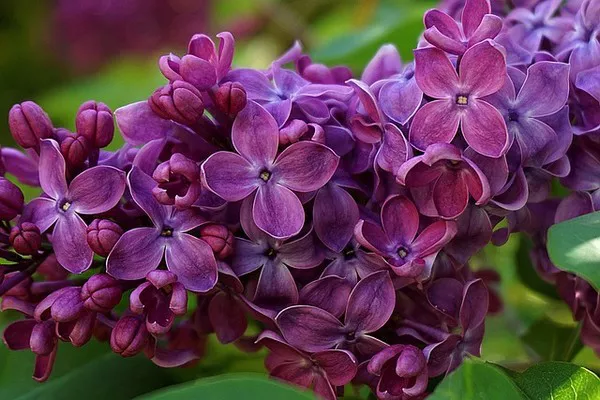Lilacs, with their delicate petals and enchanting fragrance, have captivated hearts and minds for centuries. In this article, we delve into the rich symbolism behind these beautiful blooms, exploring their cultural significance, literary and artistic representations, and their meanings for various occasions. Join us on a journey through the world of lilac flower symbolism, where each blossom holds a story waiting to be discovered.
Brief Introduction and Historical Background
Lilacs, scientifically known as Syringa vulgaris, are deciduous shrubs native to southeastern Europe and Asia. Belonging to the olive family, Oleaceae, these flowers have a long and storied history, dating back to ancient civilizations. The name “lilac” is derived from the Persian word “lilak,” meaning bluish.
Introduced to Europe in the 16th century, lilacs quickly gained popularity for their beauty and fragrance. They became a beloved ornamental plant in gardens and parks, symbolizing romance and springtime renewal. Over the centuries, lilacs have been celebrated in literature, art, and cultural traditions, each culture imbuing them with its unique symbolism and meaning.
General Symbolism of Lilacs
Lilacs are imbued with a range of symbolic meanings, reflecting the universal themes of love, renewal, and innocence. Their delicate blooms, often associated with the arrival of spring, symbolize the awakening of nature after the cold winter months. As such, they are frequently seen as harbingers of new beginnings and fresh starts.
In the language of flowers, lilacs convey various sentiments depending on their color. Purple lilacs, the most common variety, symbolize first love and the emotions of youthful infatuation. White lilacs, on the other hand, represent purity and innocence, making them popular choices for weddings and religious ceremonies.
Cultural Significance of Lilacs
Across different cultures and civilizations, lilacs hold a special place in folklore, mythology, and religious traditions. In Greek mythology, the story of Pan and Syringa intertwines with the origin of the lilac flower. According to legend, the nymph Syringa transformed herself into a lilac shrub to escape Pan’s advances, giving rise to the fragrant blooms we know today.
In Celtic culture, lilacs were associated with mystical powers and were often used in rituals and ceremonies. They were believed to possess protective qualities and were planted near homes to ward off evil spirits.
During the Victorian era, the language of flowers reached its peak in popularity, with each bloom carrying a specific meaning or message. Lilacs, with their intoxicating scent and delicate beauty, were prized for their romantic connotations, symbolizing love, courtship, and affection.
Lilacs in Literature and Art
Lilacs have inspired countless poets, writers, and artists throughout history, serving as powerful symbols in literature and art. In literature, authors have often used lilacs to evoke themes of love, longing, and nostalgia. One of the most famous literary references to lilacs is found in Walt Whitman’s poem “When Lilacs Last in the Dooryard Bloom’d,” where the flowers serve as a symbol of mourning and remembrance.
In art, lilacs have been depicted in various mediums, from oil paintings to watercolors. Artists like Vincent van Gogh and Claude Monet were particularly drawn to the ethereal beauty of lilacs, incorporating them into their floral compositions as symbols of fleeting beauty and the passage of time.
Lilac Flower Meanings for Different Occasions
The symbolism of lilacs makes them a perfect choice for a variety of occasions, from weddings to funerals. Their delicate fragrance and romantic associations make them popular choices for bridal bouquets and wedding décor, symbolizing the purity and innocence of love.
For birthdays and celebrations, lilacs convey sentiments of joy, happiness, and friendship, making them thoughtful gifts for loved ones. In times of grief and loss, white lilacs offer solace and comfort, serving as a symbol of remembrance and eternal peace.
When selecting lilacs for specific occasions, consider the color and its associated meaning. Purple lilacs are ideal for expressing feelings of love and passion, while white lilacs convey purity and reverence.
Gifting Lilacs: Choosing the Right Message
When gifting lilacs, consider the message you wish to convey and choose the appropriate color accordingly. Purple lilacs are perfect for expressing romantic love and admiration, making them ideal for anniversaries and Valentine’s Day. White lilacs, with their pure and innocent beauty, are suitable for weddings, christenings, and other religious ceremonies.
For friends and family, yellow lilacs symbolize friendship and happiness, making them thoughtful gifts for birthdays and celebrations. Pink lilacs, with their delicate hue, convey affection and gratitude, making them perfect for expressing appreciation and admiration.
Beyond Symbolism: Lilac Uses and Benefits
In addition to their symbolic meanings, lilacs offer practical benefits and uses. The fragrant blooms are often used in perfumery and aromatherapy, prized for their calming and soothing properties. Lilac essential oil is used in skincare products and massage oils, promoting relaxation and stress relief.
Medicinally, lilacs have been used for centuries in traditional herbal medicine for their anti-inflammatory and antibacterial properties. The flowers, leaves, and bark contain compounds that have been shown to have therapeutic effects, including relieving headaches, reducing fever, and promoting overall well-being.
Conclusion
In conclusion, lilacs are more than just beautiful flowers—they are symbols of love, renewal, and innocence that have captivated hearts and minds for centuries. Whether adorning a wedding bouquet, inspiring a poet’s verse, or offering solace in times of grief, lilacs continue to enchant and inspire us with their timeless beauty and rich symbolism. As we celebrate the arrival of spring, let us pause to appreciate the delicate blooms of the lilac, a reminder of the eternal cycle of life and the enduring power of nature’s beauty.


